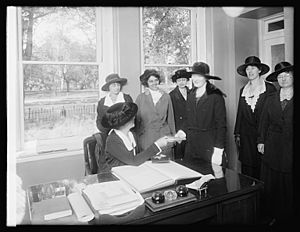United States Women's Bureau facts for kids
The United States Women's Bureau (often called the WB) is a special part of the United States government. It works within the United States Department of Labor. The Women's Bureau was created by the U.S. Congress in 1920.
This agency is unique because it's the only part of the federal government that must speak up for women who work and earn money. It helps make sure their needs are heard when new rules and plans are made for the country. The person in charge, called the Director, is chosen by the President and approved by the Senate. They work with a team in Washington, D.C., and in ten offices across the country.
How the Women's Bureau Started
In 1918, President Woodrow Wilson created a group called the "Woman in Industry Service." This group was the first step toward the Women's Bureau we know today. The Women's Bureau itself was officially started in 1920 by a law passed by Congress.
The first leader of the Women's Bureau was Mary Anderson. She had worked for the earlier "Woman in Industry Service." Mary Anderson stayed in charge through World War II, a very important time for women workers.
Helping Women Workers Over Time
In 1922, the Women's Bureau looked into the working conditions for Black women in factories. They also worked hard to make sure women were included in the Fair Labor Standards Act of 1938. This law set rules for things like minimum wage and overtime pay.
During World War II, many men went to fight, so more women were needed for jobs. The Women's Bureau and other groups helped the number of women in the workforce grow from 12 million to 18 million by 1942. Women's pay often doubled or even tripled during the war. However, after the war, the difference between what women and men earned for the same work returned.
In the 1950s, the Women's Bureau focused on helping older women find jobs, especially in offices. They also played a big part in getting the Equal Pay Act of 1963 passed. This law made it illegal to pay men and women differently for doing the same job.
Later, in 1982, the Women's Bureau started a plan to encourage companies to help with childcare for their employees. In 1989, they created a "Work and Family Clearinghouse" to share information about balancing work and family life. They also worked to pass the Family and Medical Leave Act of 1993. This law lets workers take time off for family or medical reasons without losing their jobs. In 1996, the Women's Bureau shared information about how family problems can affect people at work.
Related Pages
- United States Department of Labor
- Fair Labor Standards Act of 1938
- Equal Pay Act of 1963


